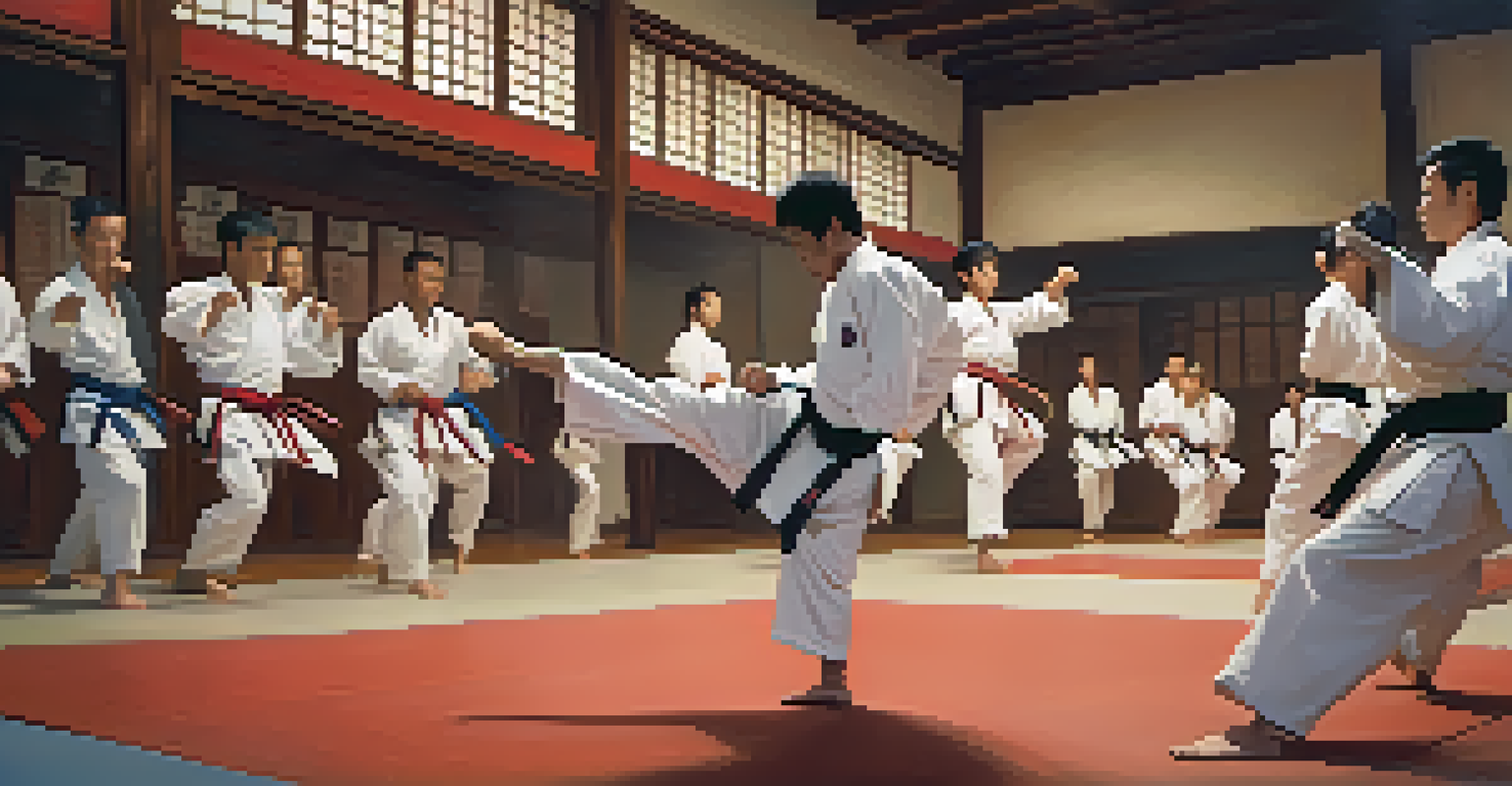The Role of Breathing Techniques in Martial Arts Self-Defense

Understanding the Link Between Breathing and Combat Performance
In martial arts, the way you breathe can significantly affect your performance. Proper breathing techniques help to maintain energy levels and focus during a fight, enabling practitioners to react swiftly and effectively. When you're calm and controlled, you can think clearly and execute techniques with precision, making breathing an essential part of self-defense.
Breath is the bridge which connects life to consciousness, which unites your body to your thoughts.
Many martial artists practice specific breathing techniques to enhance their physical abilities. For example, deep diaphragmatic breathing can increase oxygen flow, allowing for longer, more sustained training sessions. This is crucial during self-defense situations, where stamina and mental clarity can determine the outcome.
Moreover, breathing influences your body's stress response. By mastering breath control, martial artists can mitigate anxiety and fear, which are common reactions in high-pressure situations. This mental composure allows for better decision-making and the ability to remain focused on the task at hand.
Breathing Techniques: The Foundation of Focus and Control
Breathing techniques serve as a foundation for mental focus and control in martial arts. When practitioners consciously regulate their breathing, they create a mental space that fosters concentration. This focus is vital not only during training but also in self-defense scenarios where every second counts.

For instance, many martial arts disciplines, like Tai Chi and Karate, incorporate specific breathing patterns that align with movements. This synchronized breathing helps practitioners maintain rhythm and flow, enhancing their overall performance. As a result, the practitioner can execute techniques more fluidly and effectively during self-defense.
Breathing Boosts Martial Arts Focus
Mastering breathing techniques enhances concentration and mental clarity during training and self-defense.
Additionally, controlled breathing can help in regulating emotions. In a stressful self-defense situation, keeping emotions in check is crucial. By employing focused breathing techniques, martial artists can remain calm, allowing them to think strategically and avoid panic.
Enhancing Physical Performance Through Breath Control
Breathing techniques not only help with focus but also significantly enhance physical performance. By controlling their breath, martial artists can improve their endurance and strength during fights. This is especially important in self-defense situations where physical demands can be high.
The breath is the first and last thing we do in this life. It is the most important thing we can do to improve our health and well-being.
For example, techniques like 'inhale-exhale' patterns can be used to synchronize with strikes or movements. This synchronization helps to maximize power while minimizing energy expenditure, making each movement more efficient. Practitioners often find that this leads to improved overall performance, especially under pressure.
Moreover, proper breathing can assist in recovery during intense training or combat. By employing techniques such as deep, slow breaths, martial artists can reduce their heart rate and promote quicker recovery, allowing them to remain in the fight longer, should the need arise.
Using Breathing Techniques for Stress Management
In martial arts, self-defense often comes with a fair share of stress and adrenaline. Learning to manage this stress is essential, and breathing techniques play a pivotal role. By focusing on their breath, martial artists can reduce anxiety and maintain a calm demeanor, which is crucial in high-stakes situations.
For instance, techniques such as 'box breathing'—inhaling for four counts, holding for four counts, exhaling for four counts, and pausing for four counts—can help to ground practitioners. This method not only calms the mind but also prepares the body to respond effectively when faced with a threat.
Breath Control Enhances Performance
Proper breath control improves endurance and strength, allowing martial artists to perform efficiently under pressure.
Ultimately, mastering breath control allows martial artists to turn a potentially chaotic situation into a more manageable one. With practice, they can learn to quickly access their breath control during self-defense scenarios, leading to better outcomes.
The Role of Breathing in Recovery and Endurance
Breathing techniques are not just beneficial during a fight but also play a crucial role in recovery and endurance. After an intense training session or a self-defense encounter, proper breathing can help bring the body back to a state of rest. This recovery process is essential for maintaining long-term performance.
Practitioners often use controlled breathing to reduce the buildup of lactic acid in muscles, which can cause fatigue. Techniques such as prolonged exhalation can aid in releasing tension and promoting relaxation, making recovery quicker and more effective.
Incorporating breath control into recovery routines allows martial artists to train harder and longer. This enhanced endurance can be a game-changer in self-defense situations where the ability to outlast an opponent can make all the difference.
Integrating Breathing Techniques into Martial Arts Training
Integrating breathing techniques into martial arts training is a straightforward yet impactful process. Many instructors emphasize the importance of breath control from the very beginning, helping students understand how it complements their physical skills. This integration can significantly enhance a practitioner's overall capabilities in self-defense.
For example, warm-up routines often include breath-focused exercises to establish a mindful mindset. Practitioners learn to align their breathing with movements, creating a strong foundation for both physical and mental performance. This practice not only prepares them for training but also instills habits that are vital during self-defense.
Breathing Aids Stress Management
Effective breathing techniques help martial artists manage stress and anxiety, promoting calmness in high-stakes situations.
Incorporating breathing exercises into daily practice helps solidify these techniques, making them second nature. Over time, students can instinctively utilize breath control in high-pressure situations, allowing their training to shine through when it matters most.
Real-Life Applications of Breathing Techniques in Self-Defense
The real-world application of breathing techniques in self-defense is profound. In actual confrontations, maintaining composure can be the difference between success and failure. Those who practice breath control are often better equipped to handle unexpected developments and maintain their focus.
For instance, during an altercation, a practitioner who employs breath control can assess the situation calmly and make informed decisions. Instead of reacting impulsively, they can strategize and execute techniques more effectively, increasing their chances of a positive outcome.

Ultimately, the ability to control one's breath can provide a significant edge in self-defense scenarios. When faced with potential danger, practitioners who can remain calm and focused are more likely to find a path to safety.